SECTION 2. IMPLEMENTATION OF THE COMPLEX RESTORATION OF THE CHURCH OF THE TRANSFIGURATION IN 2011
 @kizhi
@kizhi
Introduction
In 2011, the 1st stage of the complex restoration of the Church of the Transfiguration was continued. In general, the measures of the preliminary period and of the 1st stage that were fulfilled during 2007–2011 could be set forth as the following:
- 1. The restoration complex was set in operation. It gives the opportunity to perform a high–quality restoration all year round and to instruct and educate restorers. The territory of the complex boasts storage facilities as well;
- The experimental restoration of two log buildings was performed in the complex to test the restoration techniques, to develop proper restoration methods, and to provide hands–on training to carpenters–restorers;
- The lifting system was mounted in the church in full; three restoration tiers were suspended and securely fixed; the remaining tiers were fixed rigidly in the space; the lowest VIIth tier was dismantled;
- The porch and refectory of the church were dismantled according to the traditional method (i. e. without lifting equipment); lots of efforts were spent on the restoration of historical floors of the XVIIth century;
- The restoration of the VIIth tier is performed indoors in the restoration complex, the original geometry of the church basement part was restored;
- The restoration site on the Pogost is fully prepared for operation including site security facilities;
- The reconstruction of the church foundation and zero circle works are going on.
Conceptually, the 1st stage of complex restoration finishes as soon as the lowest VIIth restoration tier is mounted on the original place on the reconstructed firm foundation. The corrected geometry of the restored church basement (this is in fact the VIIth tier) will be different from the deformed upper tier and, consequently, from all the remaining tiers in the church.
The major works planned for the 2nd stage of restoration are correcting the deformations in the remaining part of the church and reinforcing weak parts. The deformations will be corrected by reassembling log walls step–by–step starting from the church basement to the central cross.
In 2012, the 1st restoration stage will be completed, and the works of the 2nd stage will be started. As stipulated in the schedule, these works in 2012 include dismantling, restoration and mounting of the VIth restoration tier on the original place and dismantling of the Vth tier.
This section of the report describes in detail the workflow and results of work in 2011. The restoration was performed on two sites: Pogost (the main restoration site) and the restoration complex (the complementary site). The report explanations are backed up with photos.
2.1. THE WORKS PERFORMED ON THE KIZHI POGOST. RECONSTRUCTION OF THE FOUNDATION OF THE CHURCH OF THE TRANSFIGURATION.

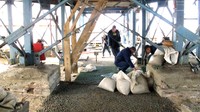
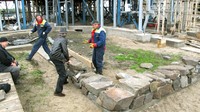
In 2011, the reconstruction of church foundations was going on. In 2010, the Kizhi Museum and «Alekon» Co ltd signed a Government contract on reconstruction of the underground part of the foundation in 2010–2011. Some part of this work was performed in 2010 according to the schedule; the remaining volume of work was completed in 2011. The building of historical rubblework i. e. the overground part of foundation on which the VIIth tier will be placed is planned for 2012.
In 2011, «Alekon» Co ltd experts completed the underground part of the foundation in line with project №255/06–КЖ and with the authors’ proposals developed by the experts of «Stroyreconstructsija» Co Ltd. The upper part of this strip foundation is made of reinforced concrete. The installation of three extra connecting beams of reinforced concrete was introduced into project №255/06–КЖ as the addition. These beams are located underground in three church annexes (northern, southern and western). Thus, they are concealed from sight and won’t spoil the appearance of the monument. The installation of extra beams was caused by the necessity to make rigid connections in three annexes due to the change of geometry of the church basement part after it has been restored in the restoration complex. Consequently, the corrected geometry caused the necessity to introduce changes into the horizontal projection of the underground part of the foundation.
After major works on foundation were completed, the planning of bottom was performed under the whole church building: the bottom was made even; the holes, trenches and earthfills made during the repairs since the XIX c. were removed. «Dornit» material was laid on the evened bottom. This material separates the historical level from the temporary covering used for work purposes. This separation could be of great use for archeologists in the future. The finishing layer of planning is a macadam base laid in the polymeric mesh with the cell dimension 60x60 mm. This mesh reinforces the macadam base and secures density and rigidity. The design of bottom in the church basement gives the opportunity to perform restoration works in comfort, improves the appearance of the church basement and restoration site on the whole, and reduces dust impact on the church wooden elements.
After the completion of the underground part of church foundation, the decision was taken to build an experimental part of the overground rubblework. A part of original rubblework was laid dry on the foundation strip of reinforced concrete. This experiment gave the opportunity to visualize the rubblework, to evaluate its appearance and design features, and to get fully prepared for the finishing woks on foundation in 2012.
2.2. THE WORKS PERFORMED ON THE KIZHI POGOST. DISMANTLING, TRANSPORTING AND STORING OF CHURCH ELEMENTS. CONSERVATION MEASURES FOR WINTER PERIOD.
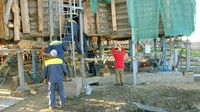
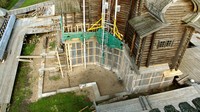
1. Dismantling of church elements
In 2010, the logs of the VIIth restoration tier were dismantled. However, due to some features of the church design, small amount of logs still remained in the church walls. This concerned mostly western part of the church that has lots of spaces between the windows and doorways.
In 2011, the dismantling of church logs from the VIIth restoration tier was going on. By the autumn, 2011, it was completely dismantled and passed to restoration. Totally 344 beams and logs were removed from the VIIth tier. The refectory floors made of half logs had been dismantled and stocked before; they will pass to the restoration on schedule in approximately 2013. After the VIIth tier had been completely dismantled, the analysis of structural stability of church building suggested to dismantle some more church elements to fix it more safely in the suspended position in winter. The decision was taken to continue dismantling log walls between the windows and doors in the western part of the church up to the upper part of these windows and doorways.
Thus, more 94 elements of the upper VIth restoration tier were dismantled and stocked in the storage facilities in autumn; these elements will be preserved and studied to find out the appropriate restoration methods. The restoration of these elements is planned for 2012.
The gap of 5 meters appeared between the foundation and suspended log walls because more logs than expected earlier were dismantled from the western part of the church. The eastern side of the church remained in the same condition like in the end of 2010 because the dismantling has not been done yet.
2. Transportation and storage
The dismantled elements of the VIth and VIIth restoration tiers were labeled and transported to the restoration complex, washed, dried and stocked on special racks. This procedure was fine–tuned in 2010 in full, and the restorers follow the steps of this procedure now. These particular steps are described in detail in the report for 2010. A special system of stocking and storage was developed to find and deliver the required elements to the restoration workshop as quick as possible. The amount of stored materials will decrease in the future. It is very likely that the volumes of dismantled elements will be reconsidered to provide good storage conditions meanwhile the concept of dividing the church into restoration tiers will stay the same.
3. Conservation of the church for winter period
After church log walls had been dismantled, the upper part of the building was fixed securely on the lifting supports and on six auxiliary holders set to support the most loaded parts and longspan walls.
As in previous seasons, the church was prepared for winter period upon the completion of all main works. The dismantled part of the church was protected with shields of wooden framing covered with reinforced material. The work technique was fine–tuned in 2010. In addition to standard measures of conservation, the following works were performed:
- taking preventive measures for the lifting equipment;
- controlling the operating condition of the church and geometric position of the upper restoration tiers;
- fixing the loosened joints of the metalwork inside.
Regarding paragraph 2.2. «Dismantling of church elements…» in general, it should be noted that the technology of dismantling, transporting and storing logs as well as the preparation of church for winter period had been fine–tuned in previous years, and this technology is preserved up to now. All activities for conservation and dismantling of church elements could be implemented with some specifications in winter as well.
Thus, it will give the opportunity to dismantle and assemble elements on the Pogost, i. e. perform the restoration, all year round. In theory, this circumstance could reduce the restoration period greatly, simplify the organization of work, and the workflow could be kept uninterrupted in time. The gaps in work are caused by summer navigation period, unfavorable weather conditions and, by the fact that the island is difficult of access in winter.
2.3. THE WORKS PERFORMED IN THE RESTORATION COMPLEX. THE RESTORATION OF LOGS AND CHURCH WALLS

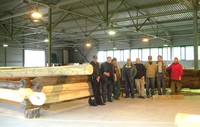
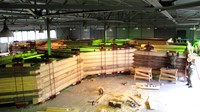
In the end of 2010, the basement part of church was assembled in the restoration complex. The horizontal projection and heights were set more precise. Thanks to this refined and corrected position in space, it became possible to eliminate the deformations of church log walls that appeared during the construction period and threatened the stability of the building. A new geometric position of log walls was corrected on the basis of theoretical research and analysis of deformations.
The correct position of church was already clarified on the stage of project development, and it is based on the thorough examination of the system of beam joints and the geometric position of church basement. The historical position of church basement (i.e. horizontal projection and vertical marks) that had formed by the time of dismantling (the middle of 2010) was corrected on the basis of the above mentioned examination and project proposal.
As a result, restorers achieved the original geometry of log walls (i.e. the geometry as of the time of church building). All beams fitted into their slots, i. e. set to the correct position, and the floor level of XVIII c. was set horizontally. The analysis of a new geometry of the church basement revealed max. horizontal shifting to 25 cm, and max. vertical shifting to 40 cm. Actually, this church basement was shown to UNESCO mission in February, 2011.
The church wall axis was marked on the floor in the restoration complex before the dismantling and then the test–assembly of log walls started. The dismantling, restoration of logs and re–assembly took place only after the marking was completed.
Museum Carpenter’s Center co–worked with «Zaonezhiye» Co ltd that won the tender to perform a preliminary assembly and restoration of the lower tier. In reality, these two units form one unified restoration team. The volumes of work and functions were agreed beforehand. Museum carpenters had the most laborious task of setting complex insertions and prosthesis into the age–old logs. Afterwards the logs passed to «Zaonezhiye» carpenters who assembled restored elements (the old ones, new ones and restored ones) in one block. The optimal way of organization in line with «quality–quantity–time» principle was found and the result was a big volume of work done with high quality.
According to the restoration project, the dismantled VIIth tier was divided into two parts. Six sets of logs had to be restored in 2011. The first part of work was accomplished and can be submitted to UNESCO mission and the Government Commission for approval. The tender for the second part of the work was held, and «Zaonezhiye» Co ltd stays the contractor. This circumstance keeps the work continuity or, in other words, the opportunity to get one restoration tier restored completely by one team.
The important restoration event was the imitation of loads from the upper part of church. This procedure was called «test–pressing of the assembled part». Special devices with jacks were brought on the island. These devices can generate the expected (designed) loads on the assembled part. Thus, the in–fact position of logs in the walls was modeled, and the quality of inserted parts (new material set into original logs) was tested.
The amount of new material today is about 40% which is a bit more than stipulated in the project. The reason is serious deterioration of logs up to completely rotten ones as well as the excessive load of church on the basement (basically the load of diagonal walls of the main octahedron). The amount of elements that have to be completely replaced will be gradually decreasing as the experts consider the lower tier the most deteriorated than the others.
The restored part of the church passed the load test successfully; it will be dismantled and reassembled on the main restoration site (i.e. in the church) next year.
It is noteworthy that every restored element of the church passed through several experts. The particular decisions for this or that part of the log were taken by the commission of experts in restoration, engineering, and architecture. Every element entered the electronic database which tracks it in all details before, during and after the restoration. The analytical report on restoration with diagrammes, illustrations and figures will be included in one of science publications.
2.4. THE WORKS PERFORMED IN WORKSHOPS ON PUDOZH SECTOR OF THE MUSEUM. RESTORATION OF THE ICONOSTASIS FRAME OF THE CHURCH OF THE TRANSFIGURATION.

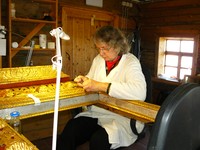
In 2011, the Kizhi Museum continued the restoration of the iconostasis frame of the Church of the Transfiguration.
The prophets tier section of the iconostasis frame was completed in 2011. The conservation of gilded surface and the frame basis was performed. The contractor is Moscow Art Research and Restoration Directorate.
Prior to starting restoration works on the Deisis tier of the iconostasis, experts from St. Petersburg «Atrium» Co. Ltd examined carefully the state of preservation in 2010. The results of this examination based adjusted cost estimations for works. The tender was won by the present contractor. The contract term lasts until the end of 2012. The work was started in the second half of 2011. The demountable parts of the Deisis tier were transported to Moscow to contractor’s workshop to keep the work going all year round. The remaining parts were restored on Kizhi Island till late October, 2011. This work will continue during the warm season of 2012. The monitoring of iconostasis condition was performed during 2011. Besides a detailed recording of the Deisis tier condition, this monitoring controlled the workflow of restoration as well. The continuous monitoring helped to solve a number of problems in restoration and in organization of work specifically on Kizhi Island.
However, there are some problems that became apparent as soon as the restoration started in 2009 and, these problems were still left without any solution in 2011. Thus, the experience of restoration in 2009–2011 revealed that the condition of dismantled iconostasis frame requires more complex and laborious approach than expected before. It became obvious that a team of 8–10 highly qualified restorers working all year round is needed to fulfill the schedule of restoration (in terms of money 15,5 mln RUB yearly). However, the museum disposes with possibilities for work of only 5–6 restorers during the warm season (i. e. 6 months). The transportation of all dismantled iconostasis elements to the contractors’ workshop is not possible due to bad condition of gilding and beams. Obviously, the restoration period should be extended at least to more 2–3 years. Another possible solution is creating conditions for year–round work and accommodations for the requisite number of experts on Kizhi Island.
The final result of restoration efforts depends on the effective solution to the problem of a year–round work on Kizhi Island.
The restoration of church interior requires the preparation of a number of elements like lighting appliances, vestments etc. The restoration of various interior elements is scheduled by the Museum in consecutive order. In 2011, the first lot of two candle–holders from the Church of the Transfiguration collection was sent to the workshops of Grabar All–Russian Art, Scientific and Restoration Center.
2.5. REPORT ON TWO WHC UNESCO–ICOMOS REACTIVE MONITORING MISSIONS ON KIZHI ISLAND IN FEBRUARY, 22–24 AND IN NOVEMBER–DECEMBER 30–4, 2011 (THE MISSIONS FOCUS WERE THE ISSUES OF RESTORATION OF THE CHURCH OF THE TRANSFIGURATION)
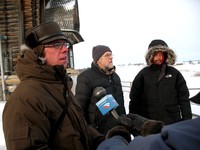
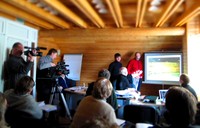
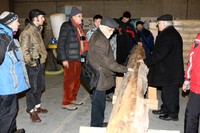
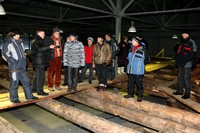
There are no common and consensual methods of restoration for log buildings. This is the reason why it was very difficult to find out a compromise and mutually acceptable settlement to the restoration of first wooden monument in the world the Church of the Transfiguration on Kizhi Island. At the same time, every particular country and even every particular restorer have their own traditions, experience, and a point of view.
The Kizhi Museum has spent many years in search of these optimal and sometimes innovative methods of restoration for the church. Different methods and techniques have been tested on some smaller size monuments of architecture. Experts from other countries within WHC UNESCO missions made a significant contribution to the theoretical part and shared their practical experience in restoration. They wrote their recommendations in annual reports that are based on the results of joint meetings, which is very important, useful and productive.
Thus, during the scheduled mission of UNESCO on Kizhi Island in February, 2011, Russian restorers came to agreement with WHC UNESCO experts about mutually acceptable principles and methods of logs restoration. Besides the restoration of separate elements, they agreed upon the method of correcting deformations in the VIIth restoration tier that was dismantled in 2010. The preliminary assembly of this tier in its intact condition was performed in the restoration complex.
The restoration of the VIIth tier (marked «A») based on these joint decisions took place in July — November, 2011. These restoration efforts needed the appraisal, which was also critical for the restores so they could feel confident at work in the future.
That is why the Museum initiated and provided financing for the unplanned WHC UNESCO mission on Kizhi Island in November, 30 — December, 4 in 2011. Andrew Powter, expert from Canada and Arnt Haugen, expert from Norway, accurately inspected the restored church elements, expressed their positive appraisal, and recommended to continue the work without stopping in no event. The preliminary positive conclusion was received by internet when this report was prepared. A detailed report of international experts is being developed. It is noteworthy to mention that Russian restorers performed expert examination side by side with UNESCO experts. The opinions of Russian and International experts coincided which proves that the evaluation was objective.
Thus, the work of Kizhi Museum restorers and contractors (both in project developing and production) was evaluated objectively and in proper time, and they got the opportunity to continue the restoration of the Church of the Transfiguration. The methods and techniques of restoration that were agreed and coordinated with all interested parties will be used for all design elements of the Church of the Transfiguration.
Two reactive monitoring missions of WHC UNESCO in 2011 once again confirmed the correctness of the chosen restoration concept in spite of the arguments of the so–called opponents to restoration.
On the whole, the active collaboration with UNESCO was commended by Sergey Lavrov, the Minister of Foreign Affairs of Russian Federation. The Director of the Kizhi Museum Elvi Averyanova was awarded a UNESCO medal and the award of Honors for her personal contribution to the collaboration between Russian Federation and the United Nations Educational Scientific and Cultural Organization (UNESCO).
2.6. CONTROLLING THE CONDITION OF LOG WALLS AND LIFTING EQUIPMENT IN WINTER AND IN SPRING AFTER THAWING
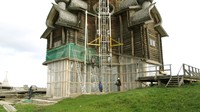
The Church of the Transfiguration was prepared for winter period upon the completion of all major works in autumn. This preparation included two basic tasks:
- to secure monument’s stability in space for a long time period before the restoration continues on the Pogost;
- to protect log walls and open space under the church from precipitations.
The first task of securing the stability in space was solved by mounting seven extra supports under church walls in addition to the existing supports of lifting equipment, and, by adjusting three suspended upper tiers of the church. These tiers are supported only by lifting equipment with the minimum clearance set.
The second task was solved by constructing a wooden framing under the church walls and by covering this framing with reinforced material. The facade screen was used to cover refectory walls. The logs and other parts that were dismantled in 2010 were stocked (preserved) in the restoration complex and their condition is under control as well.
A visual monitoring of the suspended church and lifting equipment was accomplished during the whole restoration season. Experts performed a detailed supervision after winter and the following conclusion was made: «The log walls, design elements and lifting equipment have not been damaged or deformed during the past period, they are reliable and suitable for the further restoration activities».
The precise engineering calculations for the lifting system and supplementary measures for safety will guarantee a secure conservation of the monument. The conservation technology is reliable and fine–tuned.
